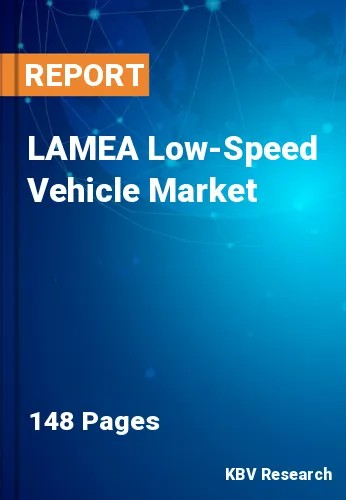The Latin America, Middle East and Africa Low-Speed Vehicle Market would witness market growth of 10.2% CAGR during the forecast period (2023-2030).
Due to their easy mobility and low top speeds, low-speed vehicles (LSVs) are being utilized more frequently in gated environments like airports, campuses of colleges, hotels, and resorts, among others. The use of LSV has also lately increased because of its benefits for the environment and the economy, including the use of zero emissions and cheaper operational & maintenance expenses. As a result, the market is anticipated to grow with the rise in demand for them in gated facilities and other facilities.
The adoption of low-speed vehicles is growing since carbon dioxide, a greenhouse gas, is released into the atmosphere by conventional vehicles burning fossil fuels like gasoline and diesel. The buildup of greenhouse gases such as carbon dioxide (CO2), methane (CH4), nitrous oxide (N2O), and hydrofluorocarbons (HFCs) is warming the Earth's atmosphere and having an impact on human health. Low-speed EVs don't produce any emissions at the tailpipe which could be an additional benefit of them.
Brazil had about 546,000 domestic and 53,000 international flights in 2021, as Agência Nacional de Aviaço Civil (ANAC) reported. With 119.4 million people transported, its markets in 2019 were 10th in the world for domestic airline passengers annually. Naturally, throughout the pandemic, this number fell dramatically. In contrast, 67.3 million passengers were transported in 2021, a 30% increase over 2020. The flourishing aviation industry in the region is estimated to raise the demand for low-speed vehicles to be used at airports.
The Brazil market dominated the LAMEA Low-Speed Vehicle Market by Country in 2022 and would continue to be a dominant market till 2030; thereby, achieving a market value of $289.3 million by 2030. The Argentina market is exhibiting a CAGR of 10.8% during (2023 - 2030). Additionally, The UAE market would experience a CAGR of 9.9% during (2023 - 2030).
Based on Category Type, the market is segmented into L7, and L6. Based on Vehicle Type, the market is segmented into Commercial Turf Utility Vehicle, Golf Cart, Industrial Utility Vehicle, and Personal Mobility Vehicle. Based on Power Output, the market is segmented into <8KW, 8-15KW, and >15KW. Based on Propulsion, the market is segmented into Electric, Diesel, and Gasoline. Based on Battery Type, the market is segmented into Li-Ion, and Lead Acid. Based on Voltage Type, the market is segmented into <60 V, and >60 V. Based on Application, the market is segmented into Golf Courses, Hotels & Resorts, Airports, Industrial Facilities, and Others. Based on countries, the market is segmented into Brazil, Argentina, UAE, Saudi Arabia, South Africa, Nigeria, and Rest of LAMEA.
Free Valuable Insights: The Worldwide Low-Speed Vehicle Market is Projected to reach USD 16.3 Billion by 2030, at a CAGR of 7.2%
The market research report covers the analysis of key stake holders of the market. Key companies profiled in the report include Textron, Inc., Deere & Company, Yamaha Motor Co., Ltd., The Toro Company, KUBOTA Corporation, Columbia Vehicle Group Inc. (Nordic Group of Companies, Ltd.), Waev, Inc., Club Car, LLC, American LandMaster, and Suzhou Eagle Electric Vehicle Manufacturing Co., Ltd.
By Category Type
By Vehicle Type
By Power Output
By Propulsion
By Battery Type
By Voltage Type
By Application
By Country
Our team of dedicated experts can provide you with attractive expansion opportunities for your business.

